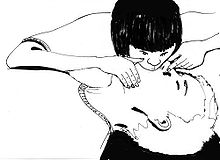Breath donation
The respiration is the respiration of an insufficient breathing unconscious patient with the exhaled air of the helper and is based on the blowing (insufflation) of the exhaled breath of the dispenser directly or via a breathing mask in the nose and / or mouth of the patient. It is part of the emergency life-saving measures . The aim is to supply oxygen to a person with respiratory arrest and / or cardiovascular arrest through the exhaled air of the first aider without delay . This form of ventilation is carried out in combination with cardiac massage as part of resuscitation . This ensures that the body is adequately supplied, especially since the exhaled air still contains around 17 percent oxygen (in contrast to the room air with 21 percent).
history
An inventor of the respiratory donation is not known, only one knows that the method is old and is also mentioned in the Old Testament of the Bible. In the 2nd Book of Kings ( 2 Kings 4.32–35 EU ) (around 700 BC) it says:
- 32 When Elisha came into the house, the child was dead on his bed. 33 He went into the room, closed the door behind him and the child, and prayed to the Lord. 34 Then he went to the bed and threw himself over the child; he put his mouth on his mouth, his eyes on his eyes, his hands on his hands. As he stretched out over the child, warmth came into his body. 35 Then he got up, paced the house once, went back to the bed, and threw himself over the child. It sneezed seven times and opened its eyes.
execution
According to the guidelines of the European Resuscitation Council of 2005, mouth-to-mouth resuscitation is considered the standard. With the patient's head overstretched, the patient's nose is closed with the hand fixing the head in an overstretched position and air is insufflated several times in succession through the mouth. Ventilation should not be carried out with too much pressure or too much volume, since overinflation of the stomach threatens regurgitation and aspiration of stomach contents. The recommended duration is around one second and the ventilation frequency around 12 insufflations per minute. An adequate volume is reached when a lifting of the patient's chest can be seen. Passive exhalation then takes place due to the elastic properties of the patient's lung tissue.
The mouth-to-nose resuscitation is an alternative if the mouth can not be opened or is injured, is difficult to achieve a seal or a patient in the water will help. The effectiveness is comparable to that of mouth-to-mouth resuscitation. The procedure corresponds to mouth-to-mouth resuscitation, the mouth must be closed.
In babies (less than one year old), due to the anatomy, the head is not overstretched, but only left in a neutral position. Ventilation requires little volume ("mouthful") and is carried out as mouth-to-mouth-and-nose ventilation (better than mouth-to-nose ventilation for infants under six months of age, due to the relatively large tongue). If the child is older than a year, the procedure is the same as for an adult and the head is overstretched.
Duration
The resuscitation and chest compressions as part of cardiopulmonary resuscitation are carried out until the patient shows signs of life again, the helper is relieved by the rescue service or another qualified helper, or until the helper is too exhausted to continue providing help.
Risks
Through direct contact with body fluids, there is a risk of disease transmission when breathing is donated; however, this is usually low; there is no known transmission of HIV or hepatitis viruses. Some of the helpers are afraid of infection or are disgusted with a donation of breath. In such a case, chest compressions without resuscitation are recommended as this is much more important in the initial phase of resuscitation. The risk of infection can be reduced by using various ventilation aids (masks, air-permeable pieces of fabric, cloths or foils).
literature
- Walied Abdulla: Interdisciplinary Intensive Care Medicine. Urban & Fischer, Munich a. a. 1999, ISBN 3-437-41410-0 , pp. 10-12.
Individual evidence
- ↑ Walied Abdulla: Interdisciplinary Intensive Care Medicine. 1999, p. 10.
- ↑ a b c d e A. J. Handley, R. Koster, K. Monsieurs et al: European Resuscitation Council guidelines for resuscitation 2005. Section 2. Adult basic life support and use of automated external defibrillators. In: Resuscitation. 67, Suppl 1, 2005, pp. S7-S23. PMID 16321717 .
- ^ H. Ruben: The immediate treatment of respiratory failure. In: Br J Anaesth. 36, 1964, pp. 542-549. PMID 14207655
- ↑ Walied Abdulla (1999), p. 10.
- ↑ D. Biarent, R. Bingham, S. Richmond et al .: European Resuscitation Council guidelines for resuscitation 2005. Section 6. Pediatric life support. In: Resuscitation. 67, Suppl 1, 2005, pp. S97-S133. PMID 16321719 .
- ^ GC Mejicano, DG Maki: Infections acquired during cardiopulmonary resuscitation: estimating the risk and defining strategies for prevention. In: Ann Intern Med . 129, 1998, pp. 813-828.
- ^ BE Brenner, DC Van, D. Cheng, EJ Lazar: Determinants of reluctance to perform CPR among residents and applicants: the impact of experience on helping behavior. In: Resuscitation. 35 (3), Nov 1997, pp. 203-211. PMID 10203397
- ↑ KB Kern, RW Hilwig, RA Berg, AB Sanders, GA Ewy: Importance of continuous chest compressions during cardiopulmonary resuscitation: improved outcome during a simulated single lay-rescuer scenario. In: Circulation. 105 (5), Feb 5, 2002, pp. 645-649. PMID 11827933
